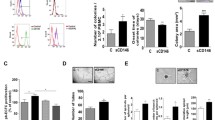Abstract
Background: Therapeutic angiogenesis aims at generating new blood vessels by delivering growth factors such as Vascular Endothelial Growth Factor (VEGF), and thus is a promising treatment for patients with peripheral arterial disease. It has previously been shown that a discrete threshold in VEGF dose exists, below which normal stable capillaries are induced and above which angioma growth occurs. However, VEGF dose must be homogeneously distributed in the microenvironment, as VEGF remains localized around each producing cell. By using retrovirally-transduced myoblasts, normal angiogenesis can be induced by implanting clonal populations, in which every cell expresses the same VEGF level. While providing proof-of-concept, this approach is not directly applicable to clinical practice. Therefore, we developed a Fluorescence Activated Cell Sorting (FACS)-based method to allow the rapid isolation of engineered myoblasts homogeneously expressing predictable levels of VEGF from a heterogeneous primary population in vitro, in order to achieve controlled microen-vironmental VEGF doses in vivo. Methods: Primary mouse myoblasts were transduced with a retroviral construct in which the VEGF164 gene is linked through an Internal Ribosomal Entry Site (IRES) to a truncated version of CD8a, acting as a reporter gene. Therefore, changes in the level of VEGF expression are reflected by the cell-surface expression of CD8a, which can be detected and quantified on live cells by FACS. Results: To determine the relationship between expression of VEGF (by ELISA) and that of CD8 (by FACS) at the single cell level, a standard curve was produced by isolating clones from all regions of the expression spectrum of the heterogeneous polyclonal population. VEGF and CD8 expression were found to be stable during expansion over 49 cell doublings in 5 sample clones producing levels of VEGF in a range of 2–142 ng/106 cells/day. We determined the VEGF dose at which aberrant angiogenesis is induced in vivo, representing the upper threshold above which safety is lost. The clone which produced the highest VEGF amount (∼40 ng/106 cells/day), while at the same time completely avoiding aberrant angiogenesis (highest safe dose) was selected as a reference to identify and sort the cells expressing similar levels of CD8a, and therefore of VEGF, out of the heterogeneous polyclonal population. We tested up to 3 successive rounds of sorting, with 2 different gates (large and narrow), in order to optimize the purity of the selection. VEGF and CD8a expression of the sorted cells was stable during in vitro expansion over 23 doublings. When implanted in vivo, the heterogeneous population always caused angioma growth by four weeks. In contrast, the sorted populations caused exclusively normal angiogenesis in 100 % of the animals implanted with narrowgate cells and 65 % with large-gate cells after four weeks. Therefore, selective sorting with a narrow gate appears to reliably avoid expression of excessive VEGF levels. Conclusion: The ability to isolate homogeneous populations expressing predictable levels of the transgene will allow the optimization of both efficacy and safety in cell-based strategies for VEGF gene delivery.
Access this chapter
Tax calculation will be finalised at checkout
Purchases are for personal use only
Preview
Unable to display preview. Download preview PDF.
Similar content being viewed by others

Literatur
Ozawa CR, Banfi A, Glazer NL, Thurston G, Springer ML, Kraft PE, McDonald DM, Blau HM (2004) Microenvironmental VEGF concentration, not total dose, determines a threshold between normal and aberrant angiogenesis. J Clin Invest 113: 516–527
von Degenfeld G, Banfi A, Springer ML, Wagner RA, Jacobi J, Ozawa CR, Merchant MJ, Cooke JP, Blau HM (2006) Microenvironmental VEGF distribution is critical for stable and functional vessel growth in ischemia. FASEB J 20: 2657–2659
Author information
Authors and Affiliations
Editor information
Editors and Affiliations
Rights and permissions
Copyright information
© 2007 Springer Medizin Verlag Heidelberg
About this paper
Cite this paper
Fueglistaler, P. et al. (2007). Therapeutische Angiogenese mittels FACS-sortierter transduzierter Myoblasten. In: Steinau, H.U., Schackert, H.K., Bauer, H. (eds) Chirurgisches Forum 2007. Deutsche Gesellschaft für Chirurgie, vol 36. Springer, Berlin, Heidelberg. https://doi.org/10.1007/978-3-540-71123-0_112
Download citation
DOI: https://doi.org/10.1007/978-3-540-71123-0_112
Publisher Name: Springer, Berlin, Heidelberg
Print ISBN: 978-3-540-71122-3
Online ISBN: 978-3-540-71123-0
eBook Packages: Medicine (German Language)



